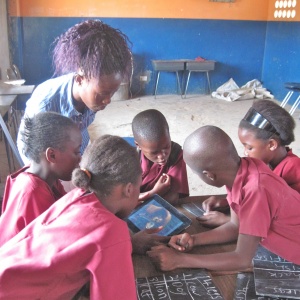OER4Schools/activities/Traffic lights
Traffic Lights (which in Zambia are usually called "robots") are a useful resource for everyday use in classrooms in order to assess. You may have heard of a piece of equipment designed to control traffic flow. It is called a robot in Zambia and more commonly referred to as traffic lights. A robot has three lights - red, orange and green. These lights signal to drivers what action they should take on the road with each coloured light having a different meaning associated with it: Red means Stop; Orange means Get Ready and Green means Go. Their meanings for classroom application in the context of AfL are:
- RED means “I’m stuck. I need some extra help. I don’t feel I have progressed.”
- ORANGE means “I’m not quite sure. I need a little help. I feel I have made some progress.”
- GREEN means “I understand fully. I’m okay without help. I feel I have progressed a lot.”
| Resource details | |
| Title | Traffic lights |
| Topic | [[Topics/OER4Schools|OER4Schools]], [[Topics/Teacher Education Resources for Sub-Saharan Africa|Teacher Education Resources for Sub-Saharan Africa]] |
| Teaching approach | [[Teaching Approaches/|]]
|
| Subject | [[Resources/Teacher Education|Teacher Education]] |
| Age of students / grade | [[Resources/|]]
|
| Related ORBIT Wiki Resources |
|
| Acknowledgement | This resource is part of the OER4Schools programme. |
Use of Traffic Lights in the classroom:
- While the teachers are teaching, they can ask students to hold up the Lights to assess if they should proceed to the next topic or not.
- Students can voluntarily show a Light indicating their current level of understanding. They can change the light several times during a single lesson. In this way, the student can bring their understanding to the teacher's notice without disturbing other classmates or the flow of the lesson. Teachers can address the student at an appropriate time.
- While working independently in groups, students can display their light on the table to indicate their current status. Teachers can visit the student to provide assistance.
Eventually students are expected to independently use the Traffic Lights without teacher's instruction to do so. The Traffic Lights should become a silent way of communicating in the class.
Traffic Lights also reduce students' physical stress of standing in queues or raising their hands while waiting for the teacher's attention.
Use of Traffic Lights in groupwork:
- While the teacher needs to know who has understood, it doesn't have to always be the teacher who responds to red or orange lights. Students working in a group can also help each other. In Unit 3 we emphasised that groupwork is most successful when groups themselves are given responsibility for making sure that all members understand. Traffic lights can alert students to the need to assist their peers.
- One Zambian teacher's reflection on trying out the technique:
[Judith quote]


